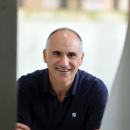In December talks in Paris involving more than 200 countries may result in a new agreement aimed at reducing carbon emissions. In the months leading up to the conference, The Economist will be publishing guest columns by experts on the economic issues involved. Here, Christoph Rheinberger (pictured right) and Nicolas Treich (at left) of the Toulouse School of Economics explain why quantifying the cost of global climate change is so difficult.
CLIMATE change puts humanity at risk. The Pope’s celebrated encyclical letter on the subject released last month emphasised this risk “for our common home”, arguing that “doomsday predictions can no longer be met with irony or disdain”. But apocalyptic predictions are often made by religious groups. So, how serious is this claim?
Perhaps for the first time in history, there seems to be a broad consensus among scientists. They claim that our planet might face a frightening future if we cannot agree to take decisive actions here and now. Changes to how seawater circulates in the Atlantic, the melting of glaciers on Greenland and in the Antarctic, and rising sea levels might all result from inaction. Accounting for these catastrophic scenarios is a huge challenge for scientists and economists alike.
So, what should we do in the face of existential risks? One, perhaps extreme, view is that the mere possibility of massive human extinction should inspire us to do everything we can to avoid it. The counterargument goes that we face several other existential risks and focusing on one may be shortsighted. In his fascinating book “Catastrophe: Risk and Response”, published in 2004, Richard Posner argues that we do not do enough to hedge against catastrophic risks such as climate change, asteroid impacts or bioterrorism. In light of the “competition” of existential risks, how much should humanity invest in the mitigation of climate change?
Conventional wisdom holds that we should limit global warming to 2°C. To justify this target, economists seek to compare the cost of reducing current emissions with its benefits. Indeed, there is a trade-off: investing more resources today in climate-change prevention leaves less to combat other immediate risks. Interestingly, the Pope’s letter recognises that “decisions must be made based on a comparison of the risks and benefits foreseen for the various possible alternatives”.
However, estimating these benefits means that we need to determine the value of a reduction in preventing a possible future catastrophic risk. This is a thorny task. Martin Weitzman, an economist at Harvard University, argues that the expected loss to society because of catastrophic climate change is so large that it cannot be reliably estimated. A cost-benefit analysis—economists’ standard tool for assessing policies—cannot be applied here as reducing an infinite loss is infinitely profitable. Other economists, including Kenneth Arrow of Stanford University and William Nordhaus of Yale University, have examined the technical limits of Mr Weitzman’s argument. As the interpretation of infinity in economic climate models is essentially a debate about how to deal with the threat of extinction, Mr Weitzman’s argument depends heavily on a judgement about the value of life.
Economists estimate this value based on people’s personal choices: we purchase bicycle helmets, pay more for a safer car, and receive compensation for risky occupations. The observed trade-offs between safety and money tell us about society’s willingness to pay for a reduction in mortality risk. Hundreds of studies indicate that people in developed countries are collectively willing to pay a few million dollars to avoid an additional statistical death. For example, America’s Environmental Protection Agency recommends using a value of around $8m per fatality avoided. Similar values are used to evaluate vaccination programmes and prevention of traffic accidents or airborne diseases.
Mr Posner multiplies the value of life by an estimate of Earth’s future population and obtains an illustrative figure of $336m billion as the cost of human extinction. Nick Bostrom, a philosopher at Oxford University, argues that this approach ignores the value of life of unborn generations and that the tentative figure should be much larger—perhaps infinitely so.
The value of life as a concept is a natural candidate for a tentative estimation of the benefit of reducing extinction risk. Yet the approach seems somewhat awkward in this context. The extinction risk here is completely different from the individual risk we face in our everyday lives. Human extinction is a risk we all share—and it would be an unprecedented event that can happen only once.
A lack of reliable data exacerbates the profound methodological and philosophical difficulties faced by climate change economists. Extinction is a threat to future generations, while evaluating and designing prevention policies is an urgent challenge today.
The United Nations conference in Paris this December offers a chance to take appropriate steps to protect future generations from this risk. Many economists do not believe in the current pledge-and-review mechanism, and favour the implementation of a generalised carbon-trading system instead. While the Pope dismisses that solution out of hand, his attacks on technological innovation and capitalism, however, may not be very effective in overcoming the current inertia that climate negotiations suffer from.




